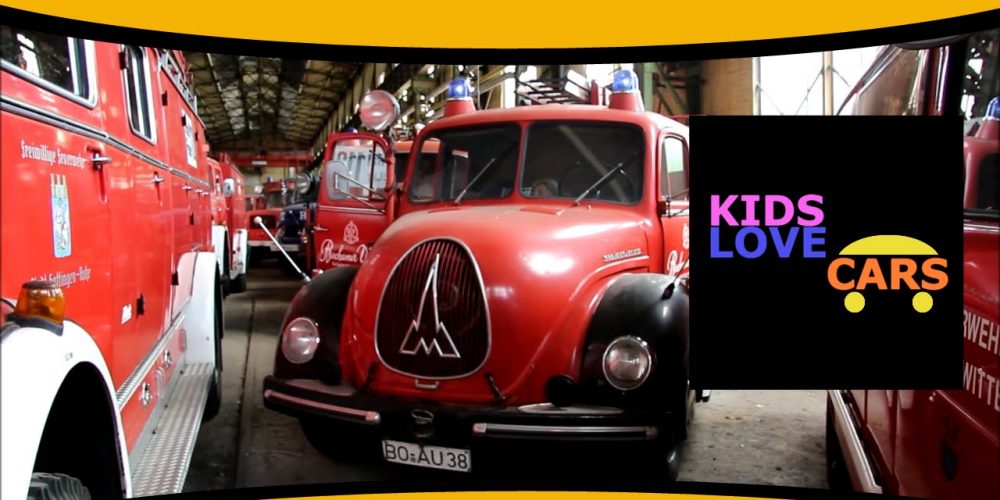This video contains fire trucks of different colors shapes and sizes using their sirens and responding to emergencies.
Fire Trucks Sirens for Kids – Kids Love Cars.
The standard fire engine is an apparatus designed primarily for firefighting operations. The primary purpose of the engine is transporting firefighters to the scene, providing a limited supply of water with which to fight the fire, and carrying tools, equipment, and hoses needed by the firefighters. The tools carried on the fire engine will vary greatly based on many factors including the size of the department and what sort of terrain the department must handle. For example, departments located near large bodies of water or rivers are likely to have some sort of water rescue equipment. Standard tools found on nearly all fire engines include ladders, hydraulic rescue tools (often referred to as the jaws of life), floodlights, fire hose, fire extinguishers, self-contained breathing apparatus, and thermal imaging cameras.
The exact layout of what is carried on an engine is decided by the needs of the department. For example, fire departments which cover metropolitan areas are more likely to assist with non-fire-related cases such as hazardous material removal/cleanup and technical rescues of people from traffic collisions or structural collapses, while rural departments may need to do things like access remote areas or extinguish forest fires.
Conventional pumper of Fire and Rescue NSW in Wagga Wagga, Australia Some fire engines have a fixed deluge gun, also known as a master stream, which directs a heavy stream of water to wherever the operator points it. An additional feature of engines are their preconnected hose lines, commonly referred to as preconnects. The preconnects are attached to the engine’s onboard water supply and allow firefighters to quickly mount an aggressive attack on the fire as soon as they arrive on scene. When the onboard water supply runs out, the engine is connected to more permanent sources such as fire hydrants or water tenders and can also use natural sources such as rivers or reservoirs by drafting water.
An early device used to squirt water onto a fire was known as a squirt or fire syringe. Hand squirts and hand pumps are noted before Ctesibius of Alexandria invented the first fire pump around the 2nd century B.C.,[20] and an example of a force-pump possibly used for a fire-engine is mentioned by Heron of Alexandria. The fire pump was reinvented in Europe during the 16th century, reportedly used in Augsburg in 1518 and Nuremberg in 1657. A book of 1655 inventions mentions a steam engine (called a fire engine) pump used to “raise a column of water 40 feet (12 m)”, but there was no mention of whether it was portable.
Colonial laws in America required each house to have a bucket of water on the front stoop during fires at night. These buckets were intended for use by the initial bucket brigade that would supply the water at fires. Philadelphia obtained a hand-pumped fire engine in 1719, years after Boston’s 1654 model appeared there, made by Joseph Jencks, but before New York’s two engines arrived from London.
By 1730, Richard Newsham, in London, had made successful fire engines; he invented the first ones used in New York City (in 1731) (this was six years before formation of the NYC volunteer fire department). The amount of manpower and skill necessary for firefighting prompted Benjamin Franklin to found an organized fire company in 1737. Thomas Lote built the first fire engine made in America in 1743. These earliest engines are called hand tubs because they are manually (hand) powered and the water was supplied by a bucket brigade dumping it into a tub (cistern) where the pump had a permanent intake pipe. An important advancement around 1822 was the invention of an engine which could draft water from a water source. This rendered the bucket brigade obsolete. In 1822, a Philadelphia-based manufacturing company called Sellers and Pennock made a model called “The Hydraulion”. It is said to be the first suction engine.[21] Some models had the hard, suction hose fixed to the intake and curled up over the apparatus known as a squirrel tail engine.
Find out more at
Video showing child friendly footage of Fire Trucks responding with Sirens.
Fire trucks responding with sirens. Videos are created with the YouTube Video Editor with the aim to be friendly for children to view.
Carefree Melody by Twin Musicom is licensed under a Creative Commons Attribution license (
Source:
Artist:
source
FEATURED BUSINESSES



 Wagga caterer offering delicious & authentic mobile catering featuring Spanish and Latin favourites
Wagga caterer offering delicious & authentic mobile catering featuring Spanish and Latin favourites mariaspaella.com.au
 We support couples and families to develop parenting skills, improve their family’s communication and create a stable and safe home environment.
We support couples and families to develop parenting skills, improve their family’s communication and create a stable and safe home environment. www.childandfamilytherapist.com
 Balding Constructions are your choice for a new home builder in Wagga Wagga NSW. Our construction team of professional tradesman have extensive experience to ensure offer a reliable and efficient service to meet your building or renovation needs. waggawaggabuilder.com.au
Balding Constructions are your choice for a new home builder in Wagga Wagga NSW. Our construction team of professional tradesman have extensive experience to ensure offer a reliable and efficient service to meet your building or renovation needs. waggawaggabuilder.com.au
 Wagga Web Design offer website design and SEO services to Wagga Wagga and surrounding area
Wagga Web Design offer website design and SEO services to Wagga Wagga and surrounding area SEO Wagga Wagga
 Jet Hair by Jennie are among the best hair salons in Wagga Wagga. Get in touch with us to make an appointment. We are sure you will love our personal service that makes you feel at ease throughout the entire appointment. You will find us upstairs at 1/ 56 Baylis St, Wagga Wagga.
Jet Hair by Jennie are among the best hair salons in Wagga Wagga. Get in touch with us to make an appointment. We are sure you will love our personal service that makes you feel at ease throughout the entire appointment. You will find us upstairs at 1/ 56 Baylis St, Wagga Wagga.
jethairbyjennie.com.au
 Universal Scientific Laboratory is a long-established chemical testing facility specialising in a wide range of inorganic chemical analysis and testing.
Universal Scientific Laboratory is a long-established chemical testing facility specialising in a wide range of inorganic chemical analysis and testing. usl.com.au
 Paisley Robertson Accountants are more than just another Wagga Wagga accounting firm offering accounting and taxation compliance services. They are a proactive and innovative accounting and advisory firm offering a number of services including accounting, advisory, bookkeeping, taxation and SMSF advice. paisleyrobertson.com.au
Paisley Robertson Accountants are more than just another Wagga Wagga accounting firm offering accounting and taxation compliance services. They are a proactive and innovative accounting and advisory firm offering a number of services including accounting, advisory, bookkeeping, taxation and SMSF advice. paisleyrobertson.com.au
 Solution focused counselling Wagga Wagga offer counselling, CBT, PTSD debriefing, trauma counselling, psychological intervention and life coaching/mentoring in Wagga Wagga. counsellingwaggawagga.com
Solution focused counselling Wagga Wagga offer counselling, CBT, PTSD debriefing, trauma counselling, psychological intervention and life coaching/mentoring in Wagga Wagga. counsellingwaggawagga.com



